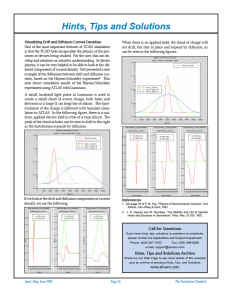Hints, Tips and Solutions
Visualizing Drift and Diffusion Current Densities
One of the most important features of TCAD simulation is that the TCAD tools encapsulate the physics of the processes or devices being studied. For the user, this can develop and reinforce an intuitive understanding. In device physics, it can be very helpful to be able to look at the different components of current density. Sze1 presented a nice example of the difference between drift and diffusion currents, based on the Haynes-Schockley experiment2. This note shows simulation results of the Haynes-Schockley experiment using ATLAS with Luminous.
A small, localized light pulse in Luminous is used to create a small cloud of excess charge, both holes and electrons in a large (1 cm long) bar of silicon. The time-evolution of the charge is followed with transient simulation in ATLAS. In the following figure, there is a uniform, applied electric field in a bar of n-type silicon. The peak of the cloud of holes can be seen to drift to the right as the distribution expands by diffusion.



